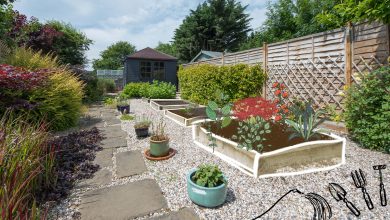Transplant Basil: [Conditions, Time, Tools and Land Preparation]
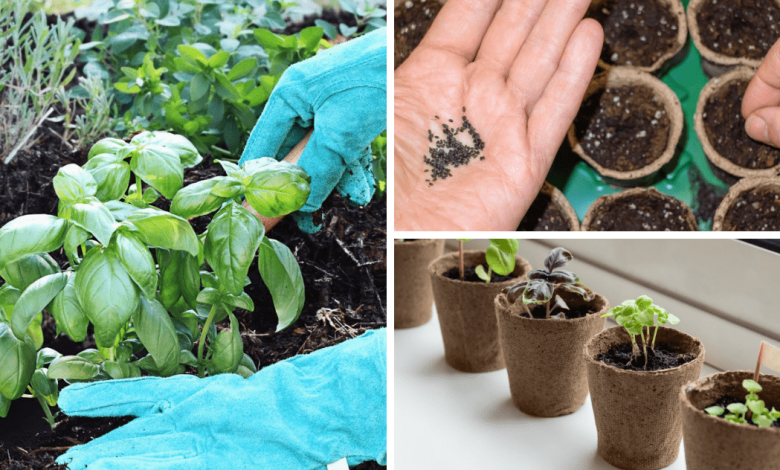
Basil is an annual plant native to India and Persia, with a size that ranges between 30 to 50 centimeters in height, very aromatic, with various applications in the kitchen.
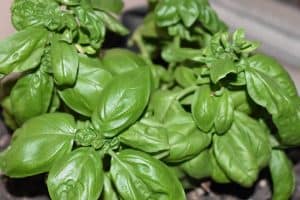 It belongs to the Labiataes family and its scientific name is Ocimum Baciculim.It can reproduce very easily supported by the technique of reproduction by cutting or by seedbeds.
It belongs to the Labiataes family and its scientific name is Ocimum Baciculim.It can reproduce very easily supported by the technique of reproduction by cutting or by seedbeds.
They bloom in the summer, when their white or purple flowers multiply in spikes throughout the plant.
It grows very healthy in pots, as well as in gardens, where it usually becomes an effective pest repellent (whitefly and aphids) that dare to attack our garden.
But its greatest fame is associated with gastronomy, because it is essential in the preparation of many sauces, salads, marinades and delicious tapas. It also has medicinal applications, being effective to combat vomiting and nausea in pregnant women.
A very simple way to achieve their multiplication, in order to keep them always at home, is by using cutting reproduction techniques, which begin with the selection of a few twigs in good condition.
What should we take into account before transplanting basil?
Basil requires certain conditions to grow successfully, whether in a pot or outdoors, or in a home garden.
- Requires good natural lighting or partial shade. You should never receive it directly because it will wilt and burn quickly.
- It has the great advantage that it can adapt to any climate, be it Mediterranean or continental. However, it is very sensitive to frost, because it prefers warm climates, with temperatures ranging from 15ºC to 25ºC. Below 10ºC or above 35ºC its growth slows down.
- It needs well-drained soils, with good oxygenation, without greater demands in terms of nutrients, although the most important thing is that the soil has been previously fertilized.
- Irrigation must be abundant, so you must have a good system that always keeps it hydrated, but never allow the soil to become waterlogged.
- A good substrate should be chosen when transplanting the plant, such as slightly acidic peat rich in decomposed nutrients.
What is the right time to transplant basil?
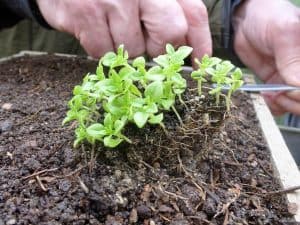 A home way of growing basil plants starts with collecting seeds from an adult plant in the fall.
A home way of growing basil plants starts with collecting seeds from an adult plant in the fall.
These should be reserved in a paper bag or can also be purchased at a specialized horticultural store. As this aromatic is hyper sensitive to low temperatures.
They should be sown in mid- spring and the seedlings will be transplanted about 15 days after the seeds have germinated, previously sown in a pot with good organic fertilizer, 1 or 2 centimeters deep.
When the first leaves are seen, between 8 to 10 centimeters high and these multiply to reach half a dozen, then it will be ready for transplanting, which must be done in the morning, before the sun reaches fullness and they need watering..
Its roots are delicate, so you have to be very careful when handling them when transplanting them into a pot about 20 to 30 centimeters high, which must have enough fertilized soil that drains smoothly.
What tools should we use when transplanting basil?
- Work desk.
- Pot with basil seedlings, or tender plants previously selected.
- New pot 20 to 30 centimeters high, prepared enough fertilized soil.
- A fork to extract the plant without mistreating the roots.
- A water sprayer.
How do we prepare the land?
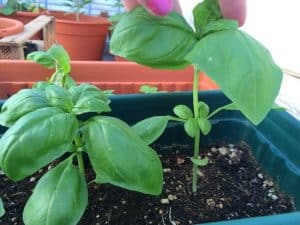 As it is a plant that dehydrates quickly, the soil must be made up of a land with enough raw material that allows it to drain in balance, because it cannot be too dry or soggy.
As it is a plant that dehydrates quickly, the soil must be made up of a land with enough raw material that allows it to drain in balance, because it cannot be too dry or soggy.
Basil feels comfortable with moist soils, rich in nutrients and with excellent drainage, so the composition of the land must allow good water filtration, in order to prevent it from becoming stagnant.
As it is a plant that dehydrates easily, very quickly, irrigation is key and should be done frequently, so soils with generous organic matter are very good. Therefore, the use of vermiculite or perlite will be sufficient to guarantee ideal permeability.
The sand of course also offers good results. A well-prepared compost and garden loam will have excellent results, but if peat is used, the soil must be fertilized more frequently in the first months of the plant’s life, to provide it with all the nutrients.
It is therefore convenient to use a proportion of 2 parts of organic material with 1 part of porous material.
Bibliography and references
- Green, Alice. (2007). The book of spices. Aromatic herbs and spices. Robinbook Editions. Barcelona, Spain.
- Fonnegra G., Ramino; Jiménez R., Silvia Luz. (2007). Medicinal plants approved in Colombia. Editorial University of Antioquia. Medellin Colombia.
- Osorio, Juan Rangel. (2014). Establishment of in vitro cultures of basil (ocimum basilicum) for the production of essential oil. Autonomous Mexico State University. Toluca, Mexico. Reproduced from: http://148.215.1.182/bitstream/handle/20.500.11799/14819/Tesis.417185.pdf?sequence=1
- Moncayo Lujan, Maria del Rosario; Alvarez Reyna, Vicente de Paul; Gonzalez Cervantes, Guillermo; Salas Perez, Lilia; Chavez Simmental, Jorge Armando. (2015). Organic production of basil in a greenhouse in the Laguna region. Terra Latin American Publisher. Mexican Society of Soil Science, AC Chapingo, Mexico. Reproduced from: http://www.redalyc.org/articulo.oa?id=57335800006

![Photo of Shepherd’s Purse: [Cultivation, Irrigation, Care, Pests and Diseases]](https://www.complete-gardening.com/wp-content/uploads/2022/08/shepherds-purse-cultivation-irrigation-care-pests-and-diseases.jpg)
